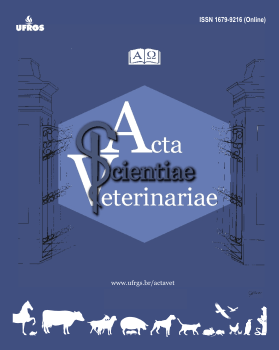Trichoblastoma in a Dog: A Clinical, Diagnostic and Therapeutic Analysis
DOI:
https://doi.org/10.22456/1679-9216.102485Abstract
Background: Trichoblastoma is a rare skin neoplasm derived from the primitive hair follicle, having epithelial and mesenchymal components. Despite being commonly described as a benign tumor, there are reports in the literature of tumors with characteristics of malignant neoplasia. It affects adult dogs and cats, with no predilection for sex. Although rare, in studies in Brazil the pathology shows variable rates of occurrence. This work describes a case of tricoblastoma in a 4-year-old mixed breed dog, submitted to care at the Veterinary Hospital of the Federal University of Western Bahia (HVU-UFOB).
Case: A 4-year-old male mixed breed dog with 7 kg of body weight, was referred to the HVU-UFOB. The main complaint reported by the canine’s tutor was an increase in volume in the region of the animal's face, which evolved slowly, associated with itching, bleeding and sensitivity to touch. During the physical examination, a round, elevated mass was observed in the subcutaneous tissue of the left face, in the mandible region, with local alopecia. On palpation, the neoformation showed a firm consistency, well-defined and fluctuating, with no solutions for continuity or discomfort to touch. The animal's physiological parameters were within the normal for the species. CBC, chest X-rays, abdominal ultrasound and aspiration cytology of the mass were requested. The blood count and image tests did not reveal any changes. On cytological examination, small, grouped basal epithelial cells were observed, characterized by a high nucleus-cytoplasm ratio, monomorphic nuclei and intensely basophilic and pigmented cytoplasm, a suggestive diagnosis of basal cell tumor. Due to the findings, an excisional biopsy of the mass was performed, with margins of 2 cm. The mass with its margins was sent for histopathological examination at the Animal Pathology Laboratory of the HVU. Macroscopically, an expansive mass was observed, covered by skin, was well defined, not encapsulated, distending the dermis, with a dome shape, measuring 8.0 x 5.0 x 4.0 cm in length, white and firm to the cut, with discrete lobulation. Microscopically, there was a proliferation of small cuboidal to elongated cells with a round to oval nucleus of loose chromatin and little evident nucleolus, and of a pale, scarce eosinophilic cytoplasm. Neoplastic cells were sometimes arranged in strings, palisades (ribbon type) or islands and were sometimes seen centrally aggregated emitting strands of cells (medusoid type) separated by moderate fibrovascular stroma, compatible with trichoblastoma. Tissue healing occurred satisfactorily, and the stitches were removed 10 days after the surgical procedure.
Discussion: The clinical analysis of the case associated with the cytological and histopathological examination of the lesion allowed the visualization of physical and cellular changes, confirming the diagnosis of trichoblastoma. The animal involved was 4-years-old, within the chronological variability most affected by the tumor. The macroscopic lesions and the location of the neoplasia were also similar to those described in the literature. However, their race (mixed breed) was different from the most evident. Treatment based on total surgical excision of the neoplasia proved to be effective. This work is the first reported in the Western of Bahia describing a case of trichoblastoma in a dog.
Downloads
References
Coleto A.F., Moreira T.A., Gundim L.F., Silva S.A., Castro M.R., Bandarra M.B. & Medeiros-Ronchi A.A. 2016. Perfil de exames citológicos, sensibilidade e especificidade da punção por agulha fina em amostras cutâneas e subcutâneas em cães. Revista Brasileira Medicina Veterinária. 38(3): 311-315.
Emanuelli M.P. & Bohn A.A. 2014. What is Your Diagnosis? Dermal Mass in a Dog. Veterinary Clinical Pathology. 43(2): 285-286.
Goldschmidt M.H. & Hendrick M.J. 2002. Cytokeratins as Markers of Follicular Differentiation: An Immunohistochemical Study of Trichoblastoma and Basal Cell Carcinoma. American Journal of Dermatopathology. 23(6): 501-509.
Gross T.L., Ihrke P.J., Walder E.J. & Affolter V.K. 2009. Tumores Foliculares. In: Doenças de Pele do Cão e do Gato. São Paulo: Roca, pp.588-624.
Kumar Y.S., Chandra B.K.S., Girish S., Bhat S. & George A. 2015. A Rare Case of Melanotic Malignant Trichoblastoma. Journal of Cancer Research and Therapeutics. 11(2): 496-497.
Machado A.C.G., Fontes T.N., Laranjeira D.F., Lima A.E., Moreira E.L.T., Ribeiro L.S., Pinto M.P.R. & Peixoto T.C. 2018. Incidence of skin tumors in dogs in Salvador, Bahia state, Brazil (2007-2016). Pesquisa Veterinária Brasileira. 38(11): 2139-2145.
Mendes A.R., Ferioli R.B., Reis G.F.M.D., Murakami V.Y. & Scaramucci C.P. 2015. Tricoblastoma com Diferenciação da Bainha Externa da Raiz em um Cão com 5 Meses de Idade. In: 42º Congresso Brasileiro de Medicina Veterinária e 1º Congresso Sul-Brasileiro da ANCLIVEPA (Curitiba, Brazil).
Santos I.F.C., Cardoso J.M.M., Soares J.F., Assis A.C.G., Gomes M.V.F. & Tannus F.C.I. 2016. Tricoblastoma em cão jovem (canis lupus familiaris) - primeiro relato de caso na república de Moçambique, África. Acta Veterinaria Brasilica. 10(4): 357-362.
Published
How to Cite
Issue
Section
License
This journal provides open access to all of its content on the principle that making research freely available to the public supports a greater global exchange of knowledge. Such access is associated with increased readership and increased citation of an author's work. For more information on this approach, see the Public Knowledge Project and Directory of Open Access Journals.
We define open access journals as journals that use a funding model that does not charge readers or their institutions for access. From the BOAI definition of "open access" we take the right of users to "read, download, copy, distribute, print, search, or link to the full texts of these articles" as mandatory for a journal to be included in the directory.
La Red y Portal Iberoamericano de Revistas Científicas de Veterinaria de Libre Acceso reúne a las principales publicaciones científicas editadas en España, Portugal, Latino América y otros países del ámbito latino





